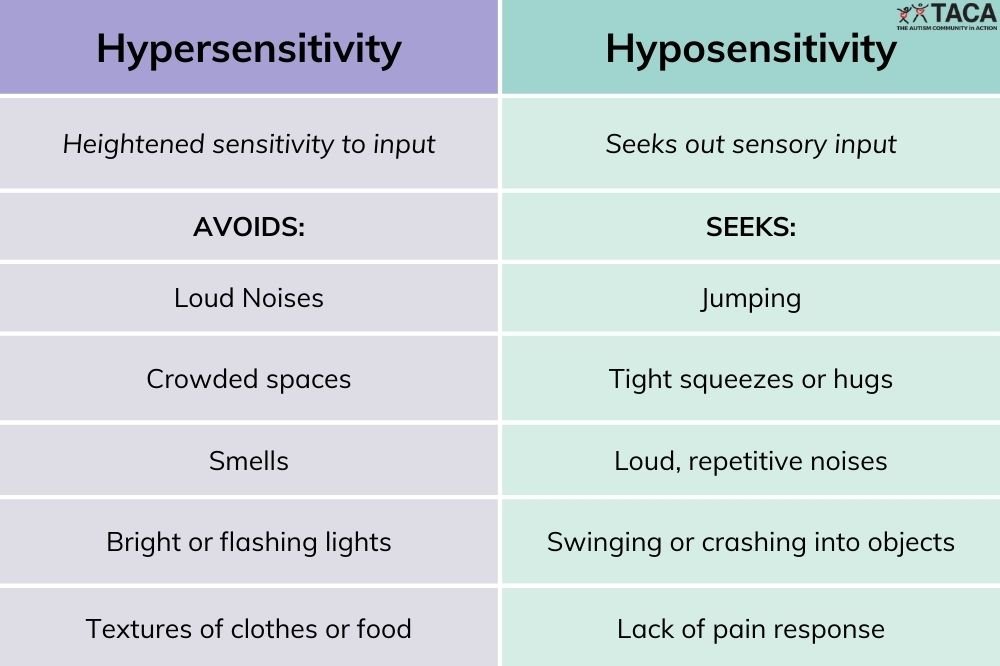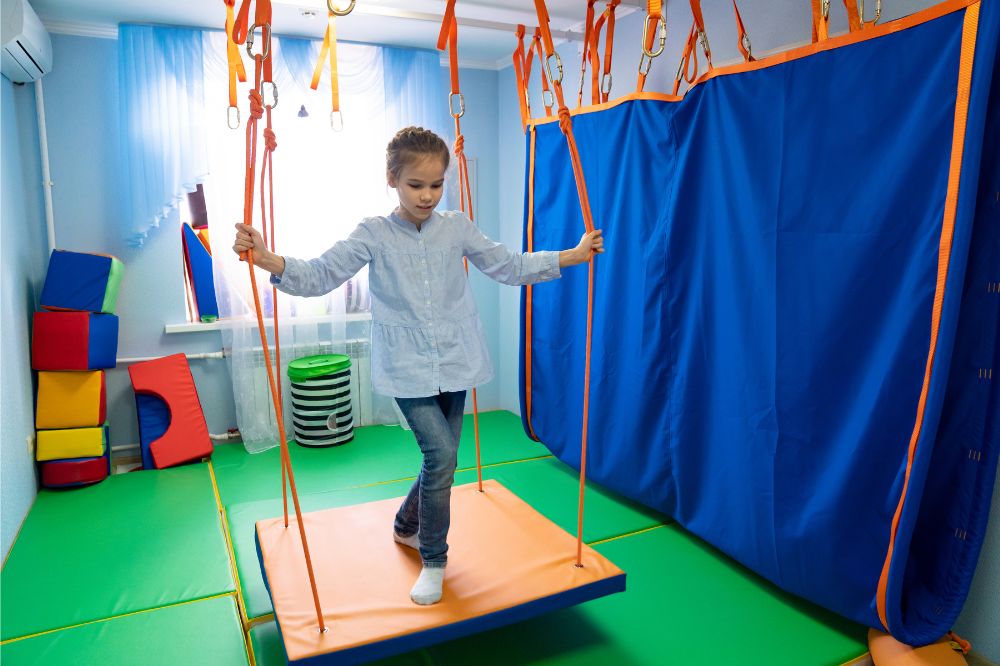Sensory Processing Disorder in Autism

All contents of this resource were created for informational purposes only and are not intended to be a substitute for professional advice, diagnosis, or treatment. Always seek the advice of your physician, therapist, or other qualified health providers with any questions or concerns you may have.
Autism Spectrum Disorder (ASD) is a developmental condition characterized by challenges with social skills, repetitive behaviors, and communication. A significant aspect that often accompanies autism is sensory sensitivity, where individuals experience abnormal responses to sensory stimuli. This can manifest in several ways:
Over-sensitivity
Excessive reactions to sounds, touch, or lights, leading to discomfort or avoidance behaviors.
Under-Sensitivity
Diminished reactions to sensory input, such as lack of response to pain or extreme temperatures.
Sensory seeking
A constant need for sensory stimulation, which may include touching textures, moving constantly, or making noises.
People can be both sensory-seeking and sensory-avoidant depending on the type of sensory stimuli. For example, someone may avoid loud noises while also seeking deep pressure.
Sensory Processing Disorder in Autism
Sensory Processing Disorder (SPD) is a condition where the brain has trouble receiving and responding to information that comes in through the senses. This may include difficulties processing sight, sound, touch, taste, or smell. While SPD can occur in individuals without autism, it is particularly prevalent among those with ASD.
Prevalence and Recognition
Studies suggest that sensory processing difficulties are present in over 90% of children with autism. SPD can exacerbate the typical challenges faced by individuals with autism, complicating their social interactions, educational experiences, and everyday activities.
Exploring Types of Sensory Sensitivities in Autism
Individuals with autism often experience sensory sensitivities that can affect their daily activities and interactions. These sensitivities are generally categorized into two main types: hypersensitivity and hyposensitivity. Understanding these can help caregivers and professionals develop more effective strategies for support and intervention.

Hypersensitivity: Navigating a World of Sensory Overload
Hypersensitivity, or sensory overload, occurs when an individual experiences sensory inputs more intensely than others. This heightened sensitivity can lead to significant discomfort and avoidance behaviors.
Common Triggers
Auditory Sensitivity
- Loud noises such as alarms
- Crowded spaces
- High pitched sounds
- Background noise such as traffic or an air conditioner Visual sensitivity
Visual Sensitivity
- Bright lights
- Flashing lights
- Visually cluttered spaces
Tactile Sensitivity
- Unexpected touch
- Certain textures
- Tags in clothing
- Rough fabrics like denim
- Food textures
Behavioral Responses
Avoidance: Individuals may avoid environments and situations where these stimuli occur.
Distress: Reactions can include covering ears, squinting, or withdrawing to cope with the discomfort.
Overwhelm: Extreme cases can lead to meltdowns where the individual loses control over their emotions due to sensory overload.
Management Strategies
Environmental Adjustments: Create sensory-friendly environments by controlling lighting, noise levels, and physical contact.
Personal Coping Tools: Use headphones, sunglasses, or comfort objects to help manage sensory input.
Gradual Exposure: Slowly introduce sensory stimuli in a controlled manner to help desensitize the individual’s response over time. If you are in a new place, have an escape plan if you need to leave quickly.
Hyposensitivity: Seeking Sensory Input
Hyposensitivity involves under-reactions to sensory stimuli, where the individual’s sensory threshold is unusually high. People with this type of sensitivity may seek out intense sensory experiences to feel more connected with their environment.
Common Characteristics
Physical Input: A preference for heavy physical contact, like tight hugs, or enjoying activities like jumping or bumping against objects.
Visual Input: Fascination with bright or flashing lights or certain colors/patterns.
Auditory Input: Seeks constant auditory stimulation, such as loud, repetitive noises and background sounds, such as keeping the TV on all day.
Behavioral Indications
Risk-Taking: May engage in behaviors that could be dangerous due to a lack of response to typical pain stimuli.
Constant Movement: Difficulty staying still; may seek constant motion to gain proprioceptive feedback.
Management Strategies
Structured Sensory Activities: Provide safe opportunities for sensory input, such as weighted blankets, resistance tunnels, or therapy swings.
Sensory Time: Schedule in specific times for sensory-rich activities to satisfy needs without overwhelming the individual.
Safety Measures: Ensure the individual’s environment is safe for their sensory-seeking behaviors.
Understanding the Impact of Sensory Processing Issues on Daily Life
Sensory issues can disrupt many aspects of daily life, making ordinary situations challenging. Here’s how sensory processing issues can affect daily life, social interactions, and learning.
Activities of Daily Living
Routine Tasks: Simple activities like dressing, bathing, or eating can become overwhelming due to discomfort from textures, temperatures, or other sensory input.
Environmental Navigation: Sensory sensitivities can make it difficult to cope in environments that are too bright, loud, or crowded.
Sleep Issues: Sensitivities to touch and sound can disrupt sleep patterns, affecting overall health and mood.
Social Interactions
Communication Barriers: Difficulty managing sensory input can hinder social interactions, making it hard to maintain conversations or form relationships.
Misunderstood Behaviors: Reactions to sensory overload (covering ears, avoiding eye contact) may be perceived as inappropriate behavior.
Social Withdrawal: The overwhelming nature of sensory-rich environments may lead individuals to withdraw from social situations to avoid discomfort.
Learning Environments
Concentration Challenges: Constant sensory stimulation can impair the ability to focus.
School Participation: Difficulty with sensory integration can make typical school activities, like gym class, music class, eating in the cafeteria, and changing classes in crowded hallways stressful.
Adaptation Needs: Accommodations in the IEP may be necessary to create a learning environment that considers sensory issues.

Emotional and Behavioral Impact
Emotional Regulation
Stress and Anxiety: Constant sensory challenges can lead to heightened stress levels, resulting in anxiety and even panic attacks.
Mood Swings: The strain of managing sensory inputs can cause rapid shifts in mood.
Frustration and Anger: The inability to effectively communicate sensory discomfort and needs can lead to frustration, which may manifest as anger or aggression.
Behavioral Issues
Avoidance Tactics: Engaging in behaviors to avoid sensory input, such as refusing to participate in activities or staying in controlled environments.
Sensory Seeking or Avoiding: Extreme behaviors may develop, such as repeatedly touching object for sensory feedback or completely avoiding certain textures.
Meltdowns: Overwhelming sensory experiences can lead to overstimulation and meltdowns. This is where individuals lose control over their emotions and actions, often in response to what seems like minor triggers to others.
Strategies for Support
Predictable Routines: Create structured daily schedules to reduce sensory surprises.
Therapeutic Interventions: Use occupational therapy techniques like sensory integration therapy to help manage reactions to sensory stimuli.
Emotional Coaching: Teach coping skills, including relaxation techniques and mindfulness, to manage emotional responses to sensory overload.
Professionals Involved
A multidisciplinary team is essential for a comprehensive assessment of Sensory Processing Disorder.
Occupational Therapist: Specializes in sensory integration therapy and can assess sensory responses.
Neurologist: Helps rule out other neurological conditions that might mimic or compound sensory processing issues.
Functional Medicine Provider: Investigates root causes of sensory issues and develops a medical treatment plan.
Conclusion
Understanding Sensory Processing Disorder (SPD) within the context of Autism Spectrum Disorder (ASD) is crucial for caregivers, educators, and therapists. The involvement of specialized professionals such as occupational therapists, neurologists, and functional medicine providers forms the backbone of effective diagnosis and management planning. These interventions ensure that each individual’s unique sensory needs are met with the most appropriate and effective care.
Next, read TACA’s article on the Effective Management of Sensory Processing Disorder in Autism. This article discusses the therapeutic and medical options available for managing these sensory challenges. It will also include a closer look at the variety of interventions that can be utilized to help individuals navigate their world more comfortably.




